Subtotal: $
Checkout
Hiking Newfoundland
Tectonic plates collide and heave, exposing the earth’s mantle. The God who formed these geological marvels is indeed a God of movement.
By Joseph S. Pagano
September 30, 2022
The Atlantic Vision arrives in Port aux Basques, Newfoundland. My eyes squint and blink in the early morning light as I drive our U-Haul out of the gaping ferry exit onto the quay. My wife, Amy, and I head north on the Trans-Canada Highway, the Gulf of St. Lawrence sparkling and blue on our left, the Long Range Mountains scrubby and green to our right. Two and a half hours later, we turn into the Humber Valley. The Humber River, smooth and black, snakes through deep cuts in limestone and dolomite on its way to the Bay of Islands. We pull up to our new home: the rectory of St. David’s Anglican Church.
We arrive during the Covid pandemic. With the nonessential closed and the essential curtailed, I find solace outdoors. The portable spirituality of Ignatius sustains me. As I walk the rugged coastlines and sturdy hills of Newfoundland, I am encouraged to find God in all things. Scriptural contemplation sharpens my imagination and hones my sensations to the feel, smell, sight, and sound of the place. On lonely walks, I fall easily into intimate conversation with the Lord, who feels near. I find consolation in desolate landscapes.
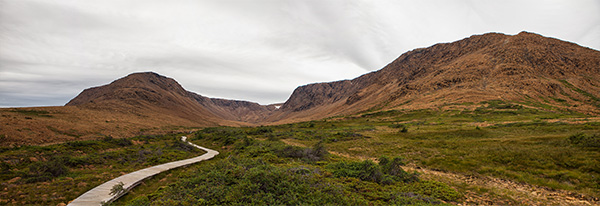
Entering the Tablelands, Newfoundland Photograph by mrbanjo1138
The geological history of Newfoundland is a story of movement. Memorial University geoscientist Harold “Hank” Williams, a pioneer in understanding plate tectonics, dubbed this movement the “Harry Hibbs Effect” after a well-known Newfoundland accordion player. The plate tectonics theory says that the earth’s crust is divided into approximately twenty plates that are in constant motion, in different directions and at varying speeds. Like the billows of an accordion, when squeezed they form mountain ridges, when pulled apart they flatten into ocean basin.
The God of Israel is a God of movement. Unlike many ancient deities, the God of Abraham, Isaac, and Jacob is not bound to a single place.
In the accordion tune that eventually formed Newfoundland, the first squeeze took place more than a billion years ago. The Uranus Ocean disappeared as the eastern edge of the North American plate collided with other plates, creating the supercontinent Rodinia. Along the collision line, the Long Range Mountains rose in what is known as the Grenville orogeny. Around 600 million years ago, the accordion bellows expanded and Rodinia broke apart. The Iapetus Ocean formed as water flooded into the rift.
About 450 million years ago, the accordion squeezed again. Continents collided, the Iapetus disappeared, and the new supercontinent Pangaea assembled. During the new mountain building event known as the Appalachian orogeny, parts of the Iapetus’ seabed and earth’s mantle were thrust upward onto the eastern edge of the Canadian Shield. This collision, along with scouring of glaciers in subsequent ice ages, shaped the landscape of Western Newfoundland.
Approximately 250 million years ago, the squeeze box opened again. The Atlantic Ocean formed as Pangaea broke apart. But it wasn’t a clean break along the previous collision line: A fragment of North Africa snapped off, forming what is now Eastern Newfoundland.
I tend to think of mountains and oceans as steadfast markers of place. If you want to get your bearings in Western Newfoundland, look around. If you can see the gulf or mountains you can easily find your way. Geoscientists look at the same mountains and oceans and see markers of extraordinary movement. Rock formed on tropical seafloors south of the equator now caps mountains in Newfoundland. Where will they be in another 500 million years? The accordion tune plays on.

Gros Morne, Newfoundland Photograph by mrbanjo1138
The God of Israel is a God of movement. Unlike many ancient deities, the God of Abraham, Isaac, and Jacob is not bound to a single place. God’s call uproots Abram from his homeland and guides him to new places, holding before him the promise of land, descendants, and blessing. God is a shepherd who leads his flock; the ancestors are sheep but also adventurers who, in response to God’s summons, step into the unknown.
The exodus from Egypt – the story of Israel’s deliverance from the yoke of Pharaoh, the crossing of the sea, the wandering through the wilderness – shows how God acts in history, and also how God creates a people. The mobile God of Israel creates a people on the go. The Song of the Sea (Exod. 15) praises the God who went before Israel in a pillar of cloud by day and a pillar of fire by night. It tells of the miraculous deliverance of Israel from the Egyptian forces at the Reed Sea when God made a path through the waters. Israel was formed by passing through the sea. The strong arm of the Lord is also mighty deft.
The waters of the sea were also in motion. Scholars are unclear about precisely where the Reed Sea is located. Probably somewhere north of the Red Sea. They are clear yam suph is not the Red Sea, a mistranslation of the Hebrew by the Septuagint. In geological terms the exact location of the Reed Sea doesn’t matter. Wherever Yam Suph may be, it still falls within the rift created by the African and Arabian plates drifting apart. The rifting is ongoing at a rate of two centimeters per year: if we date the exodus to approximately 1,300 BC that means the Reed Sea is now 6,640 centimeters wider, or about three-quarters the length of a football field. In biblical terms that’s approximately 144 cubits, or thirty turns of a chariot wheel.
After their deliverance, the people of Israel wander in the wilderness, first to Sinai, then to the Promised Land. These sojourns are times of testing, rebelliousness, and danger for the people. The wilderness in the Old Testament is harsh: a place of hunger and thirst, of thieves and madmen, of beasts and demons. And yet it is also a place where God, despite Israel’s whining and rebellion, sustains and shows steadfast love to the people in their need. God gives his beloved people a covenant on Sinai, water from a rock, manna and quail in the wilderness. In the wilderness, Israel is forced to rely solely upon God, and God proves steadfast, forgiving, and generous.
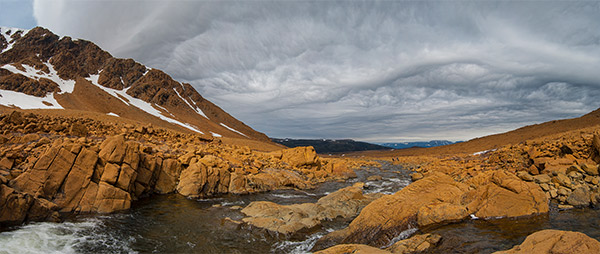
Tablelands, Newfoundland Photograph by mrbanjo1138
The Tablelands
The Tablelands of Newfoundland are one of the few places on the planet where you can walk on the earth’s mantle. When Pangaea formed, part of the earth’s mantle was thrust over the eastern edge of the Canadian Shield. Repeated scraping by glaciers exposed a portion of the mantle, which usually lies thirty to seventy kilometers below the earth’s surface.
Driving to the trailhead to hike the Tablelands on a clear September morning, our vehicle cruises between two worlds. On the right, the greens of boreal forest dominate: spruce, fir, and larch trees; moss, ferns, and sheathed sedge. The white slashes of birch trees provide some relief. On the left, the massive burnt-orange block of the Tablelands towers 700 meters above sea level. It looks otherworldly. More precisely, it is how the inner world of the earth’s mantle looks in the open air: The iron in the peridotite rusts when exposed to oxygen. Split the rock open and you will find a dark, olivine interior. Other metals in peridotite – magnesium, chrome, cobalt, copper, aluminum, and nickel – make it inhospitable to vegetation. The orange cliffs and eroded slopes shed rock into the barren valley. I can see why NASA and the Canadian Space Agency use the Tablelands as a Mars analogue site to prepare for future missions.
The Tablelands hike takes you into Winter House Brook Canyon, up the steep rock face of the escarpment, across a few miles of plateau, and then back down the northwestern rim of The Bowl, a large basin caused by landslide. We walk southeast on an exposed piece of the earth’s mantle that now forms part of the North American plate, which moves west at a rate of around two centimeters per year, at a latitude that is spinning on the earth’s axis at approximately 1,045 kilometers per hour, orbiting the sun at around 108,000 kilometers per hour, circling the Milky Way at a rate of 777,000 kilometers per hour, in a universe that we are told is expanding at a rate somewhere between 67 and 82 kilometers per second. I feel lightheaded and sit down on a peridotite boulder. I take a couple of sips of water, stand, find my balance, and start to walk into the canyon.
Gros Morne
“Gros Morne” is a Creole phrase used to describe a large mountain that is set apart. It literally means “big sorrow” or “big dismal.” A large, lonely, sorrowful mountain. Given the harsh climate of Newfoundland, it is easy to see why French fishermen gave the mountain its dreary name. But today, October 31, All Hallows’ Eve, the weather is exceptionally and unexpectedly clear. I check the revised mountain forecast. Sunny, highs around seven degrees Celsius, gentle breezes. Amy and I jump at the chance to climb Gros Morne before the snows cover the mountaintop. I fill water bottles, throw a handful of energy bars into a pack, toss gear into our vehicle, and speed to the trailhead.

Gros Morne Photograph by mrbanjo1138
Gros Morne pops up like a pink layer cake, its quartzite cap blushing and winking in the noonday sun. More than half a billion years ago, the top of Gros Morne was a tropical beach of quartz-rich sand. Pressure and heat fused the sands together, producing the hard pink quartzite now exposed on the mountaintop. The interior of the mountain is granite and gneiss, the oldest rock on the island, formed 1.2 billion years ago. In geological terms, this Precambrian filling is known as the “Grenville inlier” of the Appalachian orogeny. All those millions of years of grating and palette work by glaciers and the elements set Gros Morne apart. Today the quartzite fondant sparkles pink against a sapphire sky.
At 806 meters, Gros Morne is the tallest mountain in the park, and the second tallest on the island. The hike is a sixteen-kilometer loop that Parks Canada rates “difficult.” As we meander along the first few kilometers of the well-maintained trail I do not find it difficult. We gently gain elevation as we tramp alongside Crow Gulch Brook. Walking beside my love along a gorgeous stream with splendid waterfalls feels more picturesque than sublime. There is no sense of wildness, as yet, to evoke the frisson of terror and pain that romantics seek in the mountains. Just a walk in the park.
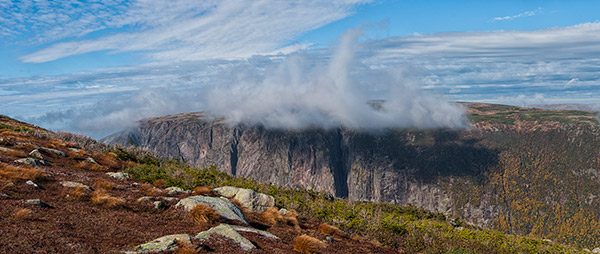
View from Gros Morne Photograph by mrbanjo1138
At about three kilometers the trail swings north. We step onto the bridge that spans Crow Gulch Waterfall. Looking down at the crash of water on the boulders below, I feel a pleasant vertiginous sensation mingle with the cool spray rising from the gorge.
The trail arcs around the base of Crow Head Mountain and across Ferry Gulch until we reach the base of Gros Morne. A warning sign greets us: Caution! Do not proceed if you cannot see the top of Gros Morne or weather conditions are deteriorating. Reduced visibility may cause you to become disorientated, become separated from your party, or fall over a cliff resulting in injury or death. The fun begins!
I think of biblical mountaintop experiences. Most involve clouds and deteriorating weather conditions. Mount Sinai, when the Lord is present, is covered in thick cloud. The earth quakes, the wind blows, there are thunder and lightning, flashes of fire, and the blast of trumpets. Scholars claim these phenomena are paraphernalia of theophanies. The manifestations of God on Sinai reveal an inscrutable Lord. Caution! The revelation of the Lord is paradoxically a hiding of God. The God revealed at Sinai is a God of the wilderness, of the forbidding wastelands between Egypt and the Promised Land, outside the control of state power or settled cult. The revealed Lord remains sovereign and free.
Earlier in Exodus, Moses encounters God at Sinai in a burning bush. God is present but not visible, manifest yet hidden. In fear, Moses hides his face and removes his sandals. However, the God of Sinai is not a vague numen, but the Holy One of Israel, the God of the ancestors, the savior and redeemer of God’s people. God appears to Moses not to give him a mystical experience, but to give him a task: deliver my people from bondage in Egypt so that they can come to this mountain and worship me.
After their deliverance from Egypt and the sojourn in the wilderness, the Israelites arrive at Sinai. They camp at the base of the mountain for about a year. During this time, Moses makes several ascents, sometimes climbing solo, sometimes accompanied by a small team. The presence of the Lord is always shrouded in thick clouds. One time the Lord places Moses in the cleft of a rock and covers him with his hand as his glory passes by. When God removes his hand, Moses glimpses the back of the Lord. Even on the mountaintop, the Lord remains elusive.
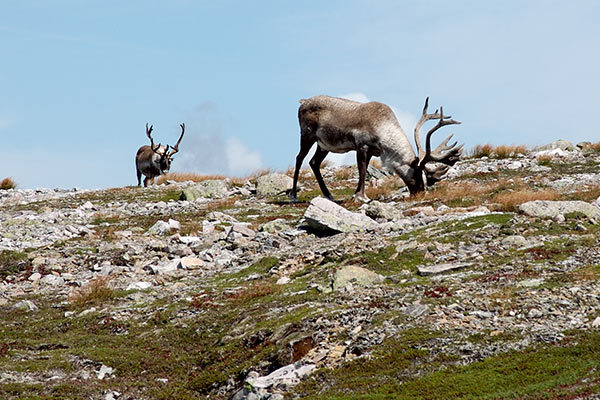
Caribou on Gros Morne Photograph by Rosino
Coming down is ultimately more important than going up: Moses comes down from the mountain with God’s offer of betrothal. The sovereign Lord of heaven and earth chooses Israel to be his treasured possession. The law is a gift from a lover to his beloved. The people of Israel were not summoned up the mountain in order to commune once with God. Rather, the Lord gave his Torah as the way in which his people could remain united to him.
Israel does not return to Mount Sinai, and today its exact location is uncertain. Perhaps that is telling. Why return to the mountaintop when the love of God came down in the law? The God of Sinai remains wild, unknown, hidden.
Stirred by the biblical narrative, I begin the ascent of Gros Morne. The sky is perfectly clear. No signs of impending theophanies. We can see the top of the mountain. Check. No outriders on the horizon from approaching storms. Check. Plenty of water. Check.
The Gully or Boulder Chute is difficult climbing. In a little over a kilometer one ascends 500 meters. The path is a scree slope that falls down the west side of the mountain. I enjoy scrambling over chunks of quartzite, using my hands, arms, and torso to pull up while my legs drive forward. This action gets me out of my head and into my body. Loose rocks clunk and grind underfoot. In some stretches, it’s two steps forward and one slide back. The occasional boulder kicks out, tumbling several meters before finding a new resting place.
About three-quarters of the way up, I pause to catch my breath. I flop my pack on top of a protruding boulder and remove my fleece and mid-layer. The cool air on my sweat soaked t-shirt feels exquisite, my skin prickling in the wind. Wedging my rear end into the crevice in the rock, I turn and look out over the fjords and the gulf. My breathing slows and the thumping in my chest steadies.
From the trailhead several kilometers away, if discernable at all, I must appear as a speck in a gully on the slope of the mountain. The proportion is pleasing. The excess of Gros Morne puts me in my place. I am here, all right, sweating, panting, and crawling up the side of a lonely mountain, and yet a mere piece of dust on the quartzite cap of a billion-year-old hunk of granite and gneiss.
Far below, a bald eagle rides the thermals. From above, his head is a white delta and his tail a splayed fan. He soars effortlessly on the air currents alongside the mountain. Isaiah said, “[T]hose who wait for the Lord shall renew their strength; they shall mount up with wings like eagles; they shall run and not be weary; they shall walk and not faint” (40:31). Feeling more goaded than consoled, I slip on my pack and trudge up the chute.
At the summit, I remove my sopping T-shirt. The cold air and wind cool and dry my sweaty torso. I spin around to take in the views. The top of Gros Morne is a big, bald head: mostly rock with some stunted vegetation. If it weren’t for the Parks Canada sign marking the spot, I wouldn’t know the precise location of the summit. Dried out and delightfully chilled, I put on my jacket, stuff the wet t-shirt into my pack, and follow the trail north.
Walking on the top of Gros Morne is easy. My eyes are free to scan, sweep, linger, and gaze. To my left, the silhouettes of a half-dozen caribou appear on the rim of the mountain. Drawing nearer, I see that their mottled coats are already turning white for the winter. Amy and I are the only people on the mountaintop. The caribou loll about, unaware or unconcerned. Soon they will migrate inland for the winter, returning to the mountain in the spring to drop their calves. We take a wide route around the area where the caribou graze and leave them be.
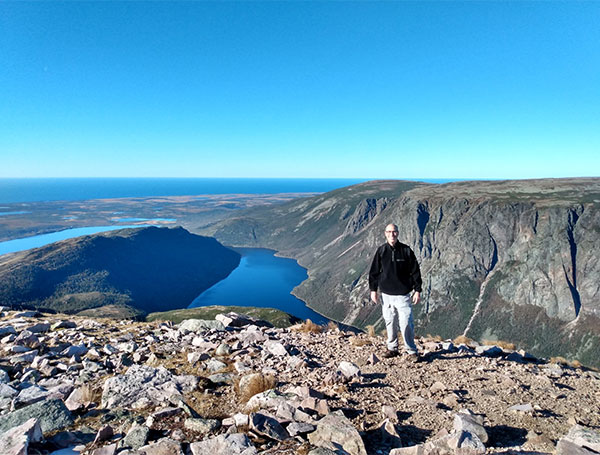
View of Ten Mile Pond from Gros Morne (author in foreground) Photograph courtesy of the author
We pause on the north side of the mountain to eat a Clif Bar and enjoy the view over Ten Mile Pond, a landlocked fjord. A deep, narrow, U-shaped valley cut by a glacier curves around the north slope of Gros Morne. The pond is actually only three miles long; apparently altitude can distort as well as clarify vision.
I seek out these desolate places because they are indifferent to my feelings, sentiments, preening. I seek the dissolution of self.
The steep drop from the mountaintop and the cliffs on the far side cast their intoxicating spell. From our perch, Ten Mile Pond looks like a blue steel blade that winds its way around the mountain. When the glaciers retreated, the waters probably flowed all the way to the sea. The coastline, however, has since risen, and Ten Mile Pond now resolves into a rivulet that dead ends in Eastern Arm Pond.
Romantic notions beset me on mountaintops. The ecstatic wonderment evoked by hoary hills and jagged peaks are followed closely by an inrush of lofty thoughts and high-minded sentiments. Looking over Ten Mile Pond, I ask God to release me from such romantic witchery. I seek out these desolate places because they are indifferent to my feelings, sentiments, preening. I seek the dissolution of self.
Western Brook Pond
On snowshoes, Amy and I break trail on the way to Western Brook Pond. It’s a cold morning in early March, about five below zero Celsius. Sheets of stratocumulus clouds billow overhead. We clomp through the powdery snow that covers the path through the frozen peat bog. When the southerly winds blow, spindrifts halo any rises in the terrain.
Western Brook Pond is a sixteen-kilometer landlocked fjord. Glaciers cut a deep gorge in the Long Range Mountains, its mouth gaping on the mountains’ western face. Today, snow and ice cling to the steep cliffs rising from the pond. In the winter’s light, the rock appears black in contrast to the white of snow and the gray of sky. Massive icicles cascade down seams cut by tributaries and waterfalls.
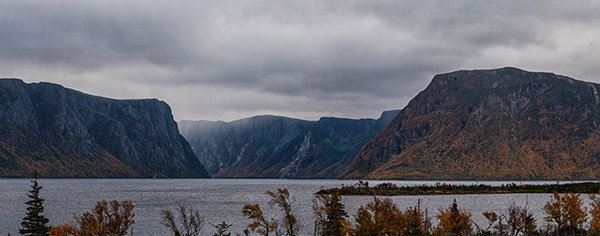
Western Brook Pond Photograph by mrbanjo1138
The glaciers sheared a textbook cross section of geologic time in the massive cliffs. The bulk of the rockface – granite, gneiss, and schist – formed over a billion years ago when tectonic plates collided in the assembly of Rodinia. Slashing through the bedrock, however, are vertical seams of 600-million-year-old diabase. When Rodinia began to break apart, molten rock shot through the fissures in the earth’s crust and hardened into dikes. Rock formed at the death of a supercontinent bisects rock formed at its birth. And here I stand.
The voice from the whirlwind comes to mind. The Lord puts questions of deep time to Job. Where were you when I laid the foundation of the earth? Who shut in the sea with doors when it burst out from the womb? Have you entered the storehouses of the snow? (Job 38:4, 8, 22). The Lord gives Job a glimpse of the vast, unfathomably deep history of the earth, and lays bare his ignorance.
The voice continues. Can you hunt the prey for the lion, or satisfy the appetite of the young lions? Do you know when the mountain goats give birth? Is it at your command that the eagle mounts up and makes its nest on high? (Job 38:39; 39:1, 27). Job covers his mouth with his hands. He had spoken of things he does not understand, things too wonderful for him. God reveals a natural world that is wild, beautiful, and terrible. It has everything to do with God and nothing to do with Job. Job repents and is comforted to be dust in God’s universe.
We return to the trailhead by the same route. Clomping on the trail we broke coming in is easier. Paraphrases fill my mind: Where were you when the Long Range Mountains were formed? Who closed up the Iapetus Ocean? Do you observe the calving of caribou on Gros Morne? Is it at your command that the bald eagle rides the thermals?
The wind picks up in the midafternoon. Breaks in the clouds appear. Gusts kick up snow devils on the peat bog, whirling in the distance. Spindrift flows like a river over rocks in the field. A shaft of sunlight catches frozen water crystals hanging in the air. They sparkle like diamonds.
Already a subscriber? Sign in
Try 3 months of unlimited access. Start your FREE TRIAL today. Cancel anytime.







TR
Your words transport me and help me see a beautiful place I will likely never visit. Thank you. The view sounds spectacular but the reminder that altitude can also distort a view is a good point too. It sometimes feels a God in the sky could and should solve all our problems, but the Lord also knows the up close details and how it can work together for good. Your description of a breathtaking experience gives us a glimpse of God’s handiwork from near and far. This modern day Job needed the awe you provided.
Laura Oliver
Lovely, informative and inspired. This reminds me of the astonishing fact that until the 1960’s the existence of tectonic plates was hotly debated among scientists. Amazing that what seems so obvious is such a relatively recent discovery, as is the revelation that being in nature specifically is actually good for us, mentally, emotionally, physically and spiritually.
Burl Self
Time is a human invention. The Han abandoned the first clock because it was of no use to an agricultural society. The solstices and equinoxes were. I’m always so spiritually uplifted to interact with God’s creation. It is every Christians duty to be an environmental activist.